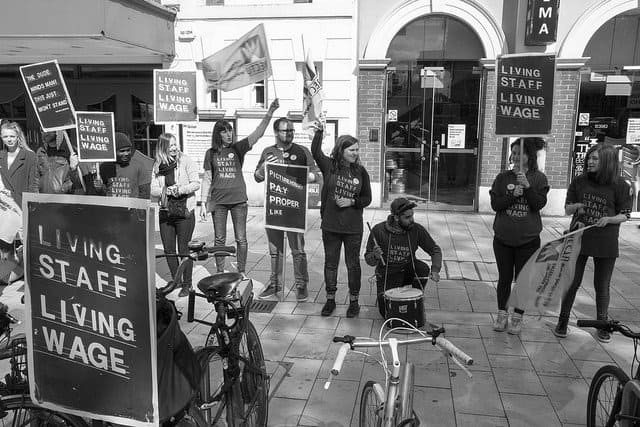How much is our labor worth? Think about these questions:
- How much money should a barber make for cutting hair? The same basic haircut in Mexico costs half the price it does in the United States.
- How much should a nanny get paid? NPR’s Planet Money reported on a nanny in New York City making a staggering $200,000/year (!!!). Yet salary estimates peg the average nanny wage in NYC at a much more modest $19/hour (or around $40,000/year)- still a lot more than a nanny is making in India, or even Indiana.
- What about a coffee picker? Nicaraguan coffee laborers annually cross the border into Costa Rica, where wages for the exact same work of cultivating coffee can be five times higher.
So how much is our labor worth? It is not so easy to stamp a price on it.
Right now, a debate over the value of labor is raging across the United States as the Fight for $15 movement advocates a raise in the minimum wage to $15/hour.
The Fight for $15 movement has gained traction in the past year. The states of California and New York have passed laws to raise the minimum wage to $15/hour through a series of gradual increases in the upcoming years, along with dozens of other cities and municipalities. The city of Seattle is the furthest along in the journey, as they just bumped wages to $13/hour at the start of 2017 on their way to a $15/hour minimum.
How do we end up with such varied wages for the same work? What is the Fight for $15 movement all about? And what do economists have to say about it?
*****
The barber, nanny, and coffee picker examples highlight the wage differences (often extreme ones) that exist between cities and countries.
Six-figure nanny salaries, cheaper haircuts in Mexico: how the heck does this happen? Prices for locally produced and consumed services, like restaurants, taxis, and barbers, vary based on area income levels. In places where incomes are high (like New York City), average price levels for these types of services are higher. In places where incomes are low (like Mexico), average price levels for these types of services are lower. Thus you find more expensive nannies in New York and cheaper haircuts in Mexico.
A higher paycheck might sound like an inherent advantage, but it can be offset in higher income areas where basic goods are more expensive. A taxi driver in San Francisco will make more money than a taxi driver in Santiago, Chile, but the prices for renting an apartment and riding the local bus will be much higher in San Francisco than Santiago. So a worker might make more, but also has to spend more for basic necessities.
*****
The objective of the Fight for $15 movement is a raise in the minimum wage, but the motives are deeper. They are fighting for minimum wage earners to be able to support themselves and their families with their labor. Too many workers across the U.S. work full-time jobs, and still can’t afford to cover their daily expenses of housing, transportation, food, health care, and education for their children. Many people resort to working multiple full-time and part-time jobs in an attempt to make ends meet. Despite their efforts, they can still come up short.
Remember that the United States is a high income country, so its average prices are high. It costs a lot to afford a place to live, to get around town, to eat healthy, to see a doctor, and get a good education. These necessities are expensive.
The Fight for $15 movement and its supporters want workers to be able to earn a living wage: sufficient payment for their full-time labor so that they can live a healthy life and care for those dependent on them. Given the cost of living in the United States, the current federal minimum wage at $7.25/hour fails to meet even the lowest estimates for a living wage in the cheapest parts of the countries. Thus minimum wage earners are stuck in poverty, even as they log full-time hours at their job. This is unjust and unacceptable.
*****
What are the effects of a minimum wage increase? Economic models propose that in a perfect market, wage floors like the minimum wage are counterproductive and lead to lesser demand for labor by employers, which is called the employment effect. In other words, those who work might get paid more with a higher minimum wage, but fewer people are able to get jobs because fewer employers are inclined to hire someone at that wage.
A problem with these economic models is that they assume a perfect market, and the real world market is anything but perfect.
There are other potential economic pitfalls as well. An employer trying to grow a profit has the incentive to look for cheaper labor. Thus factories leave the U.S. and move abroad, which has been happening for decades. A higher minimum wage could further decrease opportunities for manufacturing workers within the US. Fast food restaurants and beauty salons cannot outsource their services, but other industries can, and they would be further incentivized to do so if the costs of labor are higher.1
Who will pay for higher minimum wages anyway? The assumption is that profitable corporations can afford to pay their workers more money instead of passing on all the profits and benefits to owners or shareholders. These companies can still turn a generous profit if their payroll expenses are higher. Of course, corporations might not want to see their profits decrease at all. They could respond by raising prices, thus deferring the cost of higher wages to the consumer. Workers might start making more money, but if prices start rising as well, the cost of living will rise. Will the higher wage be enough to cover these rising costs?
Enough about theory: how do things turn out in the real world? All eyes have been trained on Seattle this year as its minimum wage rose to $13/hour on its way to $15. It has become a real world test model for economic theory. Politicians and economists across the country are following closely. What will happen as minimum wages rise?
An early report was published this summer as a working paper produced by economists at the University of Washington. These are preliminary findings and have not been subject to a peer review. The report suggests that the initial increase in the minimum wage from $9.47 to $11 had negligible effects, but the more recent increase from $11 to $13 led to overall employment losses. In short, the report makes the case that the recent increase has been counterproductive for workers. It could be that the increase to $13/hour has taken the minimum wage too high or risen too quickly.
In contrast, a separate report from the University of California, Berkeley looked at just the Seattle food services industry. The results of this study found that wages increased in this sector and that employment was not affected, which suggests that the minimum wage increase had a favorable impact for workers.
Supporters of the increase have jumped on the latter report that supports their cause, and those opposed to the raise are citing the first report. Suffice it to say that at this point, the jury is still out as these theoretical economic problems get tested in the real world arenas of cities and states across the country.
*****
How much is our labor worth?
At the heart of this question is the dignity of work and the dignity of the worker. In the words of Pope Francis, “Work is fundamental to the dignity of a person. Work, to use an image, ‘anoints’ us with dignity, fills us with dignity, makes us similar to God, who has worked and still works, who always acts; it gives one the ability to maintain oneself, one’s family, to contribute to the growth of one’s own nation.” This should be at the heart of the debate over the minimum wage.
Fundamental to the dignity of work is a living wage that can provide for the livelihood of a person and their family. Full-time work that does not cover basic material necessities degrades and exploits the worker. As the Catechism of the Catholic Church tells us, “A just wage is the legitimate fruit of work. To refuse or withhold it can be a grave injustice” (No. 2434). Although they have not published a position on the Fight for $15, the USCCB has long supported increases in the federal minimum wage to “ensure that no full time worker and their family lived in poverty.”
It remains unclear whether raising the minimum wage to $15/hour will be able to overcome the theoretical economic problems it faces. Nonetheless, as we engage this issue and evaluate results, we need to avoid the temptation to make it purely about numbers and economic theory. Let’s keep our mind on the worker and the just wage that he or she deserves. This is the minimum that we can do.
-//-
Cover image courtesy FlickrCC user M.o.B 68, found here.
- Automation is another, probably even bigger threat to minimum wage workers than outsourcing. Higher costs of labor add further financial incentives in any industry (including those that cannot outsource) to look for ways to lower costs by automating services. ↩



